As of April 30, 2025, we’re proud to announce our exciting new chapter. | Read more here.
What does it mean to design smarter? Build faster? Collaborate seamlessly? As artificial intelligence (AI) takes center stage in the architecture, engineering, and construction (AEC) industry, it’s time to ask:
How can AI-driven tools improve communication and reduce project risks?
How can we leverage data for better decision-making and sustainability outcomes?
And how do architects, engineers, and builders use AI to break down silos and work better together?
These are just a few of the big questions we’ll tackle at TECH Perspectives New York. Don’t miss your chance to explore AI’s transformative potential in shaping the future of architecture, engineering, and construction.
Here’s a look at what’s in store—check out the agenda for TECH Perspectives New York below.
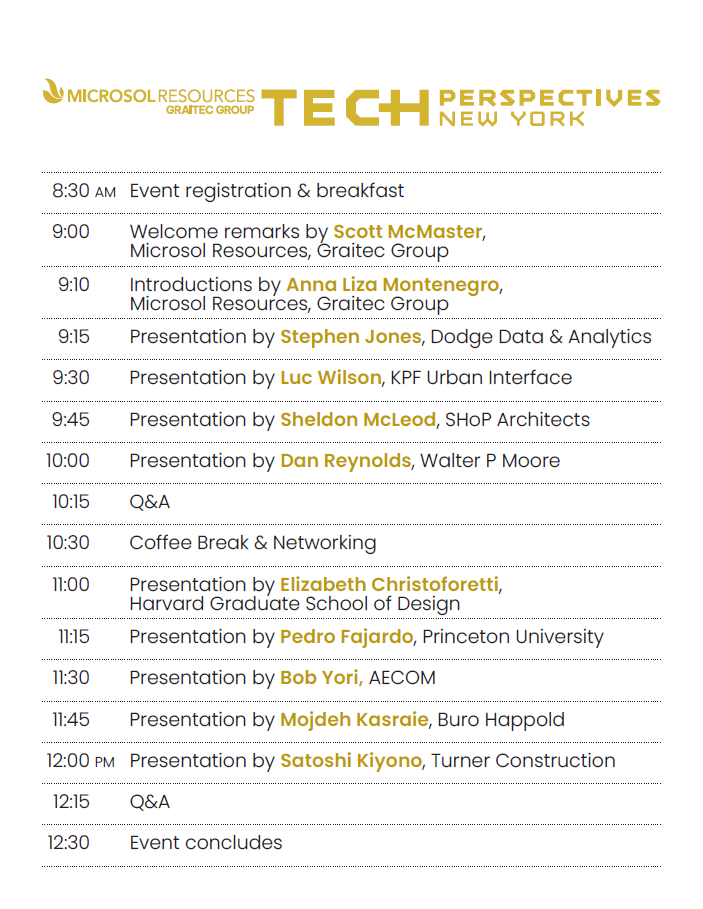

Scott McMaster is the Executive Vice President for North America at Graitec Group, Scott brings a bold, strategic vision and a proven track record of business transformation to drive innovation and growth across the region.
Scott leads a pivotal phase of Graitec’s expansion in North America, following the integration of Applied Software and the recent addition of Microsol Resources to the Graitec Group. This powerful combination brings together deep AEC expertise, customer-focused service, and cutting-edge technology to deliver even more value to clients across the architecture, engineering, construction, and manufacturing industries.
A seasoned leader with strong strategic and tactical skills, Scott excels at analyzing markets, identifying opportunities, and driving results in complex, cross-functional environments. He is passionate about cultivating high-performance cultures that empower teams and fuel long-term success.
 Anna Liza Montenegro is the Director of Marketing at Microsol Resources, Graitec Group, who develops design technology conferences for architecture, engineering, and construction (AEC) professionals as a forum to exchange innovative strategies, and best practices, and facilitate discussions into the technology trends driving significant change in building design and construction.
Anna Liza Montenegro is the Director of Marketing at Microsol Resources, Graitec Group, who develops design technology conferences for architecture, engineering, and construction (AEC) professionals as a forum to exchange innovative strategies, and best practices, and facilitate discussions into the technology trends driving significant change in building design and construction.
As a trained architect, these events are offered to AEC professionals by Microsol Resources, a value-added reseller of Autodesk, Bluebeam, Rhino, Chaos V-Ray & Enscape, and other various technology partnerships.

Stephen Jones is the Senior Director of Industry Insights Research at Dodge Data & Analytics. Stephen is a globally recognized expert in how emerging economic, practice, and technology trends are shaping the future of the design and construction industry. He speaks at conferences globally, authors the SmartMarket Report series on key industry trends, and hosts the ENR FutureTech events.
Before Dodge, Stephen was Vice President of Primavera Systems (now part of Oracle), and prior to that, spent 19 years in creative and management roles with top design firms, most recently as a Principal and Board of Directors member with Burt Hill, one of the largest A/E firms in the US (now merged with Stantec). Stephen holds an MBA from Wharton and a BA from The Johns Hopkins University.

Luc Wilson is a Director at KPF and leads KPF Urban Interface (KPFui), an internal think tank exploring the intersection of urban planning, architecture, and computational research. With his interdisciplinary team, Luc has developed a data-driven design methodology, applied to over 300 KPF projects globally, that optimizes performance metrics while centering the human experience of cities and buildings.
Luc’s expertise spans master plans, mixed-use developments, and supertall towers, including high-profile projects like Sidewalk Labs Toronto and the East Midtown Rezoning for NYC. He collaborates with Columbia, Cornell, Harvard, and NYU, and has been featured in Architectural Science Review, The Economist, Wired, and The New York Times.
A Commercial Observer “Top Young Professional,” Luc also teaches at Columbia GSAPP, where he focuses on performance-based design and urban data analytics. He’s a member of the Urban Design Forum and the Municipal Arts Society’s planning committee.
 Sheldon McLeod is part of the Interactive Visualization team at SHoP Architects, where he works at the intersection of design and emerging technology. With a background in Electrical and Computer Engineering and over five years of experience in Mixed Reality (XR), Sheldon develops tools and experiences that enhance spatial understanding, user interaction, and real-time design feedback.
Sheldon McLeod is part of the Interactive Visualization team at SHoP Architects, where he works at the intersection of design and emerging technology. With a background in Electrical and Computer Engineering and over five years of experience in Mixed Reality (XR), Sheldon develops tools and experiences that enhance spatial understanding, user interaction, and real-time design feedback.

Dan earned dual degrees in Structural Engineering and Sculpture from Penn State University and a Master of Arts in Civil Engineering from Princeton University.
 Elizabeth Christoforetti is an Assistant Professor in Practice of Architecture at Harvard University’s Graduate School of Design. Her teaching and research focus on emerging modes of design practice in the built environment. Her work at the GSD explores design methods, theories, and the technological building blocks that enable design practice to better confront the imperatives of our time, such as artificial intelligence and market-driven urbanism. Her research group within the Laboratory for Design Technologies aims to uncover the potentials for scalable systems of design by daylighting, operating upon, and designing new socio-technical systems – design that is dependent upon a combination of social and technological processes, and collaboration between them.
Elizabeth Christoforetti is an Assistant Professor in Practice of Architecture at Harvard University’s Graduate School of Design. Her teaching and research focus on emerging modes of design practice in the built environment. Her work at the GSD explores design methods, theories, and the technological building blocks that enable design practice to better confront the imperatives of our time, such as artificial intelligence and market-driven urbanism. Her research group within the Laboratory for Design Technologies aims to uncover the potentials for scalable systems of design by daylighting, operating upon, and designing new socio-technical systems – design that is dependent upon a combination of social and technological processes, and collaboration between them.
Elizabeth directs Supernormal, a design studio based in Cambridge, MA. She founded Supernormal to create meaningful and practical change through the intersection of architecture, urbanism, technology, and contemporary culture. Elizabeth directs Supernormal as an engaged design practice that meets the world exactly as it is, and with a glass that is half full.
Her design practice, research, and teaching explore the cultural implications of large data sets, human-machine collaboration, and scalable systems of design. Elizabeth’s work joins a perspective of radical pragmatism with a deep value for the potential of design imagination.

Pedro Fajardo is a BIM Manager at Princeton University’s Office of Capital Projects, specializing in digital technology for design and construction. With 12 years of industry experience, Pedro has established himself as a leader in leveraging innovative solutions to enhance project delivery.
As an Autodesk 40 Under 40 for Construction recipient, Pedro has been recognized for his exceptional achievements and contributions to the field. His background in architecture and experience with international projects provide a unique perspective on implementing BIM and construction technology across diverse environments. Pedro is passionate about exploring how the construction industry can harness technology to improve project outcomes. He constantly seeks to learn about emerging technologies and their potential applications in the built environment, often drawing inspiration from advancements in other sectors like the automotive and aerospace industries.
Throughout his career, Pedro has been instrumental in implementing cutting-edge tools and processes. His work involves streamlining workflows, improving collaboration, and driving data-driven decision-making across Princeton University’s capital projects. Pedro’s commitment to continuous learning and innovation aligns with the rapidly evolving landscape of construction technology. By staying at the forefront of industry trends, he contributes to shaping the future of project delivery and fostering a culture of digital transformation within his organization and the broader construction community.

Robert Yori leads AECOM’s Digital Solutions Studio and the Global Design Technologies Center of Excellence. Both groups enhance outcomes through practice-oriented digital transformation, design computation, data-focused workflows, and digital design and development.
Robert’s industry experience spans the architecture, engineering, sustainability, design for manufacturing, business development, innovation incubators, and software development sectors.
He serves on AIA New York’s Future of Architectural Practice Committee, is Program Manager for DBEI’s Design Technology Summit (DTS), is co-author of the Mastering Revit book series, and contributed to the AIA’s “Architect’s Guide to Building Performance.”

Mojdeh Kasraie is a licensed Architect and a Senior BIM and Computational Designer at Buro Happold, where she leads BIM practices and supports the integration of digital design tools across global projects. She plays a key role in implementing and refining BIM workflows, ensuring teams are aligned with best practices and project goals.
Moj collaborates closely with the Buro Happold development team, providing critical feedback on tool development and helping guide the successful rollout of these tools to broader project teams. With a focus on efficiency, coordination, and innovation, she helps bridge the gap between design intent and technical delivery.
She received her Master of Architecture from the University of Southern California and her B.S. in Architecture from the University of Texas.

Satoshi Kiyono is the New York Virtual Design and Construction (VDC) Manager at Turner Construction Company, a global leader in complex and innovative building projects. With a Bachelor of Architecture from Rensselaer Polytechnic Institute and a Master of Architecture from Columbia University, Satoshi brings a strong design and technology background to his role, where he focuses on advancing digital construction strategies and operational excellence.
Join us after TECH Perspectives New York on June 26, 2025, for the Graitec Solutions City Tour—an exclusive event where you’ll explore actionable solutions for enhancing data integrity, minimizing risks, and streamlining your design and construction BIM document workflows.
This event combines hands-on demonstrations of Ideate Software with an introduction to Graitec File Sync, designed to help you streamline your Revit tasks and safeguard your project files.
Taking place from 1:00 PM – 3:30 PM at the Japan Society, we’ll kick things off with box lunches provided after TECH Perspectives. Earn 2 AIA Learning Units.
Limited Seating Available—save your spot now!
In 2025, Autodesk’s State of Design & Make report anticipates AI to play a larger role in design and make industries, with tools enhancing day-to-day workflows and impacting project outcomes.
While some leaders express concerns about AI, many are still bullish on its potential to drive digital transformation and improve efficiency. AI is seen as a key enabler for sustainability, with many companies using it to optimize processes and reduce environmental impact.
Check out this insight on AI use cases within the AECO.
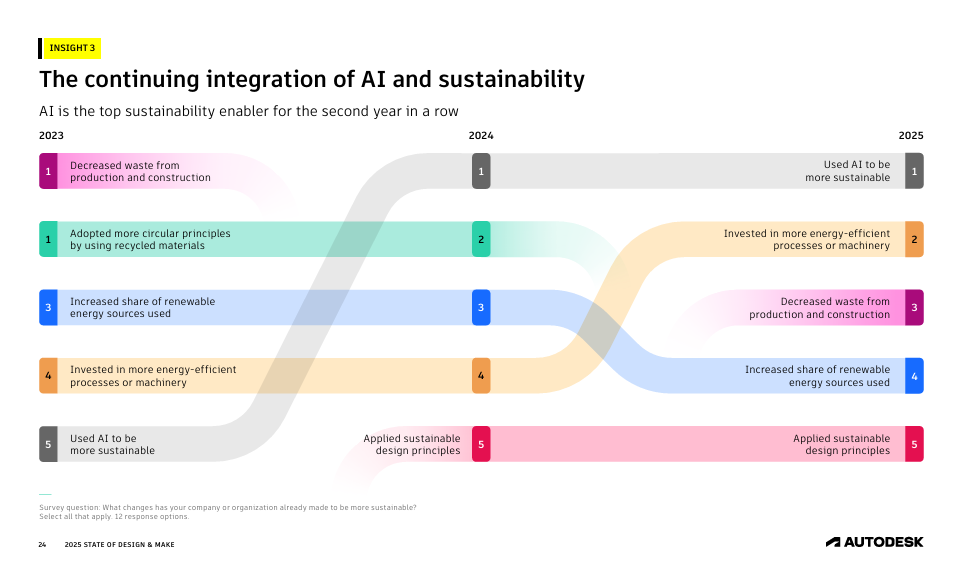
Hosted by Microsol Resources, Graitec Group and now in its 11th year and our first as part of the Graitec family, TECH Perspectives New York offers presentations on the most cutting-edge technologies and trends that are driving the architecture, engineering, and construction (AEC) industry forward.
TECH Perspectives brings together pioneers, thought leaders, and innovators to delve into the transformative power of AI in reshaping design, engineering, and construction processes.
You can view last year’s TECH Perspectives here.
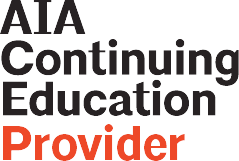
Join us at TECH Perspectives New York as we navigate the challenges and opportunities of AI in AEC, and together, unlock new possibilities for innovation and growth.
Experience hands-on technology demos and get valuable face time with industry experts. Discover new tools, gain design ideas and inspiration, and connect with industry leaders.
![]() Autodesk’s Design and Make Platform helps you get everyone on the same page to plan, design, construct, and deliver better projects.
Autodesk’s Design and Make Platform helps you get everyone on the same page to plan, design, construct, and deliver better projects.
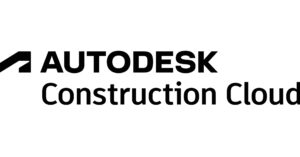 With Autodesk Construction Cloud, your project teams can collaborate securely and quickly, so you can deliver projects on time and on budget. Your single source of truth for every project as it connects teams and data from design to done.
With Autodesk Construction Cloud, your project teams can collaborate securely and quickly, so you can deliver projects on time and on budget. Your single source of truth for every project as it connects teams and data from design to done.
 In the dynamic world of architectural design and construction, efficiency is key. Ideate Software offers a suite of Revit add-ons that are engineered to streamline your BIM workflow and enhance productivity. With a focus on ease of use and powerful functionality, Ideate Software solutions are the perfect tools for Revit users looking to optimize their design process.
In the dynamic world of architectural design and construction, efficiency is key. Ideate Software offers a suite of Revit add-ons that are engineered to streamline your BIM workflow and enhance productivity. With a focus on ease of use and powerful functionality, Ideate Software solutions are the perfect tools for Revit users looking to optimize their design process.
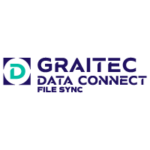 In a rapidly growing, data-driven market, Data Connect solutions enable AEC organizations to connect disparate business systems, synchronizing project and financial data seamlessly.
In a rapidly growing, data-driven market, Data Connect solutions enable AEC organizations to connect disparate business systems, synchronizing project and financial data seamlessly.
With Graitec Data Connect File Sync, the ultimate solution for protecting your critical project data safe, secure, and accessible—no matter where it lives.
 Imagine. Design. Believe. Chaos provides world-class visualization solutions helping you share ideas, optimize workflows and create immersive experiences.
Imagine. Design. Believe. Chaos provides world-class visualization solutions helping you share ideas, optimize workflows and create immersive experiences.
Photographs and/or video will be taken at this event. By taking part in this event you grant the event organizers full rights to use the images resulting from the photography/video filming, and any reproductions or adaptations of the images for publicity or other purposes to help achieve the organizer’s aims. This might include (but is not limited to), the right to use them in their printed and online publicity, social media, press releases, and website. If you do not wish to be photographed please inform an event organizer.
Join us after TECH Perspectives New York on June 26, 2025, for the Graitec Solutions City Tour—an exclusive event where you’ll explore actionable solutions for enhancing data integrity, minimizing risks, and streamlining your design and construction BIM document workflows.
This event combines hands-on demonstrations of Ideate Software with an introduction to Graitec File Sync, designed to help you streamline your Revit tasks and safeguard your project files.
Taking place from 1:00 PM – 3:30 PM at the Japan Society, we’ll kick things off with box lunches provided after TECH Perspectives. Earn 2 AIA Learning Units.
Limited Seating Available—save your spot now!
What You’ll Experience
Are you confident that your Revit models and project data are always accurate, up-to-date, and securely backed up?
Your Revit models hold the key to your project’s success—but infrequent publishing, outdated files, and inconsistent backups can put your data at risk. In this session, we’ll show you how to safeguard your Revit project data with practical strategies you can apply right away.
Learning Objectives
By the end of this session, participants will be able to:
Save your spot now for the Graitec Solutions New York City Tour. Learn how to work smarter, protect your data, and elevate your Revit workflows—all while enjoying lunch on us!
Why Attend
Don’t Miss This Opportunity
Seats are limited—secure yours now!
Who’s Presenting
 Glynnis Patterson is the Solution Line Vice President at Create–Ideate Software, Graitec Group. Glynnis is a registered architect and has worked within the building information modeling (BIM) industry since 1998. A graduate of Carnegie Mellon University, she has worked as an architect, educator, and construction site manager. Glynnis is the Director of Software Development Services and continues to work with AECO clients worldwide, developing and consulting on solutions to BIM challenges. In her spare time, Glynnis likes to cook, garden, and throw parties. She also likes to support her local community in Morristown, NJ through Grow It Green, Interfaith Food Pantry, and CoHome.org.
Glynnis Patterson is the Solution Line Vice President at Create–Ideate Software, Graitec Group. Glynnis is a registered architect and has worked within the building information modeling (BIM) industry since 1998. A graduate of Carnegie Mellon University, she has worked as an architect, educator, and construction site manager. Glynnis is the Director of Software Development Services and continues to work with AECO clients worldwide, developing and consulting on solutions to BIM challenges. In her spare time, Glynnis likes to cook, garden, and throw parties. She also likes to support her local community in Morristown, NJ through Grow It Green, Interfaith Food Pantry, and CoHome.org.
 Ninad Garware is the Technical Evangelist at Ideate Software, Graitec Group. Ninad Garware is a licensed architect with a unique blend of expertise in both architecture and customer success. He is dedicated to delivering innovative solutions that drive meaningful business outcomes. Over the course of his career, Ninad has led projects totaling over $500 million, including offices, laboratories, residential towers, and affordable housing across the United States. He has worked with internationally recognized firms such as Handel Architects, Gensler, and HOK and has previously led customer success at UpCodes, where he collaborated with AEC companies, building departments, institutions, and developers to enhance design and construction workflows through technology and strategic support.
Ninad Garware is the Technical Evangelist at Ideate Software, Graitec Group. Ninad Garware is a licensed architect with a unique blend of expertise in both architecture and customer success. He is dedicated to delivering innovative solutions that drive meaningful business outcomes. Over the course of his career, Ninad has led projects totaling over $500 million, including offices, laboratories, residential towers, and affordable housing across the United States. He has worked with internationally recognized firms such as Handel Architects, Gensler, and HOK and has previously led customer success at UpCodes, where he collaborated with AEC companies, building departments, institutions, and developers to enhance design and construction workflows through technology and strategic support.
 Tommy Moussis is a Solutions Architect for Data Connect, Graitec Group. Tommy is a seasoned technical solutions architect with over a decade of experience in teaching, consulting, and delivering comprehensive hardware and software solutions for engineering firms and manufacturing facilities throughout North America and the United Kingdom. His expertise spans a wide range of disciplines, with a strong emphasis on streamlining operations and enhancing digital workflows within the architecture, engineering, and construction (AEC) industry.
Tommy Moussis is a Solutions Architect for Data Connect, Graitec Group. Tommy is a seasoned technical solutions architect with over a decade of experience in teaching, consulting, and delivering comprehensive hardware and software solutions for engineering firms and manufacturing facilities throughout North America and the United Kingdom. His expertise spans a wide range of disciplines, with a strong emphasis on streamlining operations and enhancing digital workflows within the architecture, engineering, and construction (AEC) industry.
Currently, Tommy plays a pivotal role within the Data Connect business unit at Graitec, where he oversees both the commercial and technical strategy for File Sync across North America. He is known for his ability to align technical execution with business outcomes, ensuring that clients receive scalable and impactful solutions tailored to their operational needs.
Are you curious about the latest Autodesk features and how they can enhance your workflow? Wondering how Building Information Modeling (BIM) can drive efficiency and innovation in your projects?
At Microsol Resources, we make it easy for you to stay up to date with the latest advancements through our annual What’s New with Autodesk webinar series. These sessions dive deep into the newest features across Autodesk’s suite of tools—including AutoCAD, Revit, Autodesk Construction Cloud, Civil 3D, 3ds Max, and more—so you can maximize productivity, improve collaboration, and integrate cutting-edge BIM workflows seamlessly.
With every new release, Autodesk introduces powerful enhancements designed to optimize workflows, boost efficiency, and enhance project collaboration. Our webinars go beyond just listing new features—we focus on practical applications, expert insights, and real-world tips to help you get the most out of the latest software updates.
Missed a session? Explore our archive of What’s New with Autodesk webinar series and see how Autodesk has evolved over the years:
Microsol Resources will bring you the latest information on Autodesk products so be sure always to follow our website, blog, and social networks to stay up to date.
Stay ahead of the curve and see the demos of the new features with our building and infrastructure specialists.

Features the latest informative and technical content provided by our industry experts for designers, engineers, and construction firms and facility owners.
LEARN MORESTAY IN TOUCH